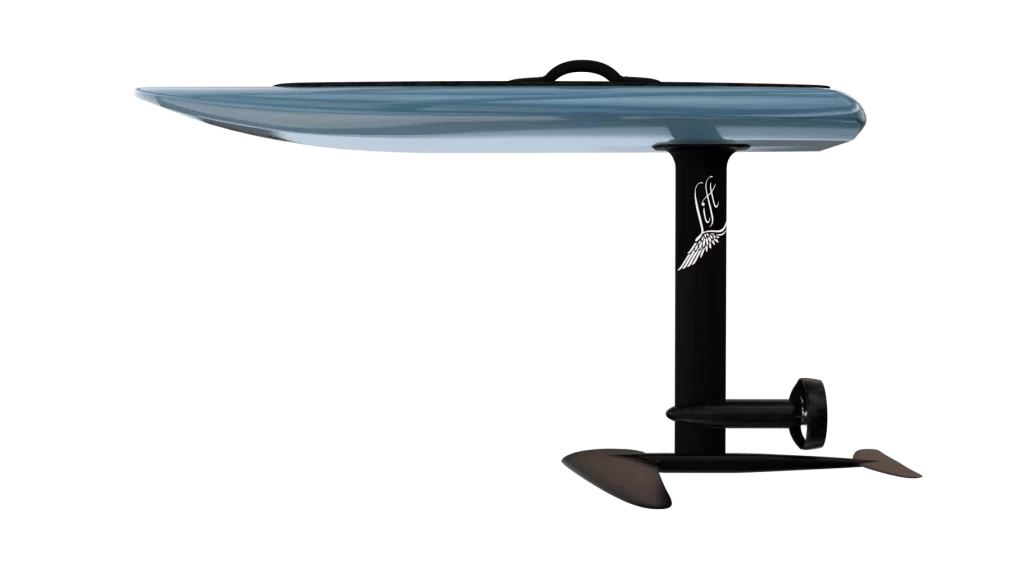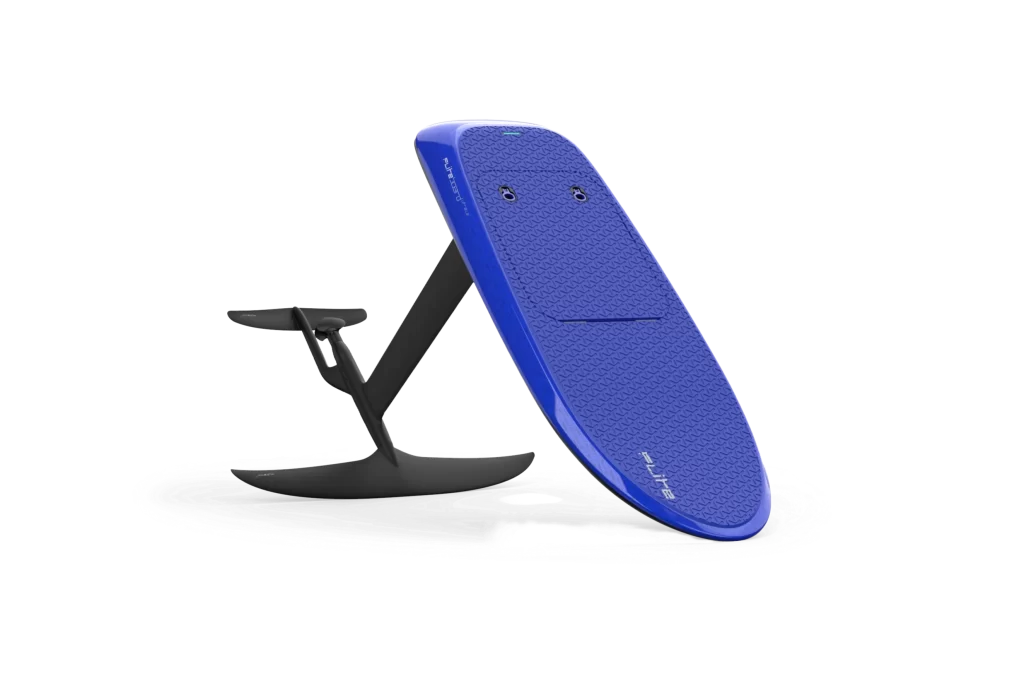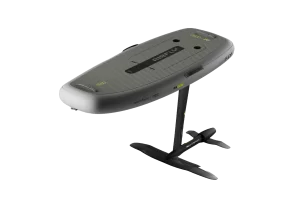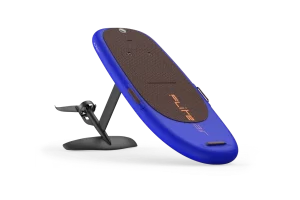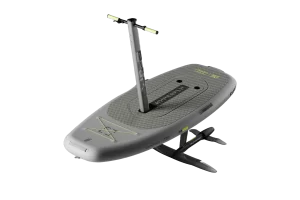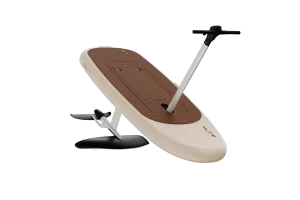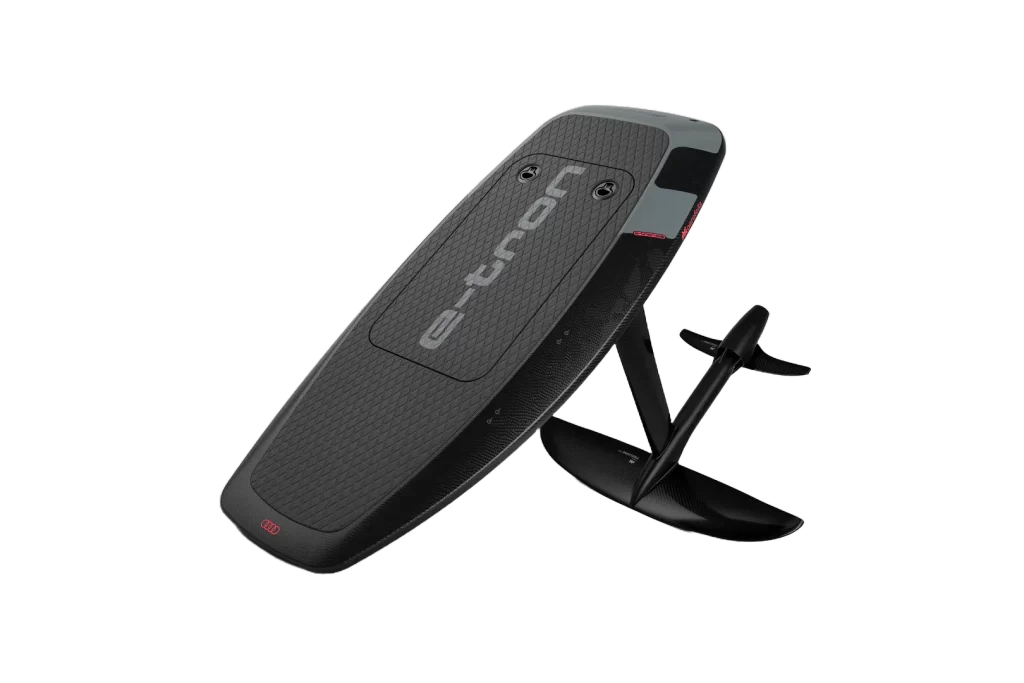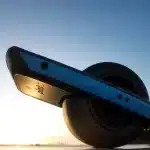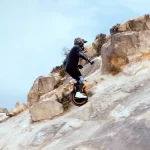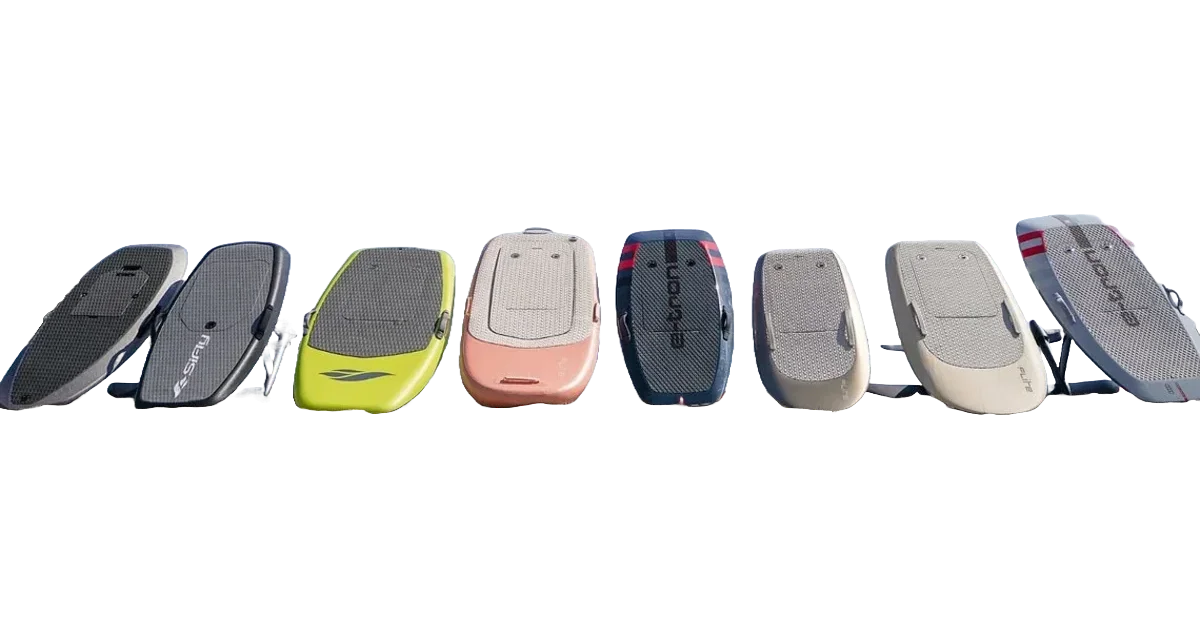
EFoiling is a unique and exhilarating experience, often considered the ultimate water activity. But eFoils are not cheap, they require a significant investment with new eFoils costing between $10,000 and $40,000 in New Zealand. So it is important to get good value for your money with a dependable product.
EFoil Brands
There have been many eFoil manufacturers of eFoils since the first commercial eFoils appeared in 2018.
- Lift is a Puerto Rican company who were first to release a commercial eFoil to the market. They were already manufacturing unpowered foils, so adapted their existing foils with a mast-mounted motor. Lift was the undisputed market leader for eFoils until around 2021, and still offer a good range of options, are well established particularly in the US market, and often chosen by the foil community as their eFoils can reuse Lift’s extensive range of wings for unpowered foiling.
- The Australian company Flite (Fliteboard) followed quickly after Lift to release their first eFoil in 2018. Unlike Lift they specifically focused on creating a dedicated eFoil from the start, and have a strong emphasis on design. They were first to place the front wing more in line with the motor, a superior design over mast mounted motors, and simplified the electronic connections required when assembling the mast, battery and board together. Flite now dominate the eFoil market with over 13,500 eFoils sold worldwide and have the largest range of eFoils and components.
- Aerofoils (Audi e-tron foil by Aerofoils) were established by German car manufacturer Audi in 2017 and started demonstrating prototypes from 2018, with their first commercial models released in 2021. Aerofoils were first to introduce jet propulsion to eFoils, having both the front wing and stabiliser inline, an anti-breach system, and larger motor designed for powering the jet. The Aerofoils range do not include low budget-level models, are often found aboard European superyachts and chosen by riders that want a more performance-oriented ride with quality German engineering.
- Chinese company Waydoo released a prototype Flyer eFoil in 2019 and refined it through a Kickstarter campaign in 2020. Despite early issues their Flyer ONE proved popular in 2021 as a budget-level eFoil, followed by the Flyer ONE Plus. Waydoo now offer good-value budget boards suitable for riders that don’t intend to later consider many upgrade options. In 2023 Waydoo lost a patent infringement case brought against them by MHL Custom for infringing two patents licensed to Lift in the US. Waydoo had much of the lower end of the eFoil market to itself until 2024 when Flite released budget Flite AIR and AIR PRO models that cost less than the Waydoo range.
- Swedish company Awake is well-known for producing Ravik electric surfboards, and in 2022 added the Vinga eFoil, which can reuse the same battery pack from its electric surfboards, saving existing surfboard owners the cost of an additional battery for an eFoil. Although heavier and bulkier than its competition it does feature a convenient quick connect mast system, avoiding the need for screws.
- SiFly is a newer Bulgarian company that produces good value eFoils with an expanding range of options and positive initial reviews.
- Likewise PWRFoil is a newer French company also producing eFoils.
However, although rapidly growing the eFoil industry has had too many competitors and it takes significant investment to keep up with the leading manufacturers. Takuma were another brand that expanded from their successful unpowered foil range to include eFoils. Unfortunately Takuma went bankrupt in 2024 and closed, so serviceability and parts are problematic. Likewise GetFoil had early reliability issues and it too closed in 2024.
There are also some very cheap options advertised via AliExpress, some which are genuine products at bargain prices. However, as E-Surfer point out:
Cheap manufacturers inevitably use cheaper components. This automatically means more support cases. At the same time, the cheaper vendors have smaller profit margins and can therefore invest less in support. Support is expensive. You have to invest in employees and in spare parts.
A few companies simply take these bargain eFoils and rebrand them as their own, so its always smart to check genuine customer reviews before purchasing an unknown brand.
EFoil Reviews
It can be challenging to find true independent reviews of the eFoil brands as most reviews are by companies or influencers that promote a particular brand, and others are by reviewers who have never tested a board themselves and are simply reviewing on paper. It is quite time consuming and expensive to assemble enough eFoils together to undertake a comprehensive review. Two that are particularly informative are:
- Divein.com 2024 review of eFoils from Aerofoils, Awake, Flite, Lift, PWRFoil, SiFly, Waydoo, also with detailed and excellent individual reviews of many of the brands.
- Inertia Tested for brands available in California, so including Flite, Lift, SiFly, Waydoo but excluding Aerofoils, Awake, PWRfoil.
Will EFoils Get Cheaper?
Although boaties are familiar with marine costs, other people that have never purchased marine equipment often are disappointed with the upfront cost of eFoils, making some cheaper options without local support seem appealing. However, with eFoils you get what you pay for. A cheap purchase that fails or puts the rider at risk and so not used becomes an expensive waste of money sitting broken in a corner of the garage.
Four years ago the founder of Flite, David Trewern was asked to justify in an interview why eFoils are not cheaper, and most of his points are still relevant. Since then battery technology has improved further but prices continue to mostly increase rather than decrease.
For instance, a larger battery with quality cells costs $6000-7000, a carbon board $7000-9000, and each wing set $1400-2000, costs that can’t be easily reduced without affecting quality or reliability. To produce a cheaper board would require large compromises on the electronics, motor or battery technology or waterproofing. To counter the rising costs of eFoils the leading brands now offer more budget-friendly options such as inflatable boards, smaller batteries and cheaper slow chargers.
EFoils Options in New Zealand
In New Zealand four brands are currently available:
- Lift eFoils are priced between approximately $17,000 (fibreglass) and $25,000 (carbon), plus shipping. The newer Lift5 start at around $28,000 plus shipping.
- Flite inflatable AIR and AIR PRO start at $12,500, their fibreglass eFoils from $16,500, carbon from $20,400, and premium eFoils up to $39,000 (with free shipping across NZ via Atomic EV).
- Aerofoils inflatable range start at $20,000 and carbon eFoils between $24,500 and $27,500 (with free shipping across NZ via Atomic EV).
- Waydoo Flyer One Plus costs $14,500 for an expanded polypropylene board and $16,500 for a carbon board, plus a small shipping charge.
None of these brands would make a poor choice if it it appropriately configured to match how you expect to ride and if supported with a NZ-based service centre. Despite Takuma being closed there are also some old Takuma stock still being advertised in NZ, but as mentioned earlier do not expect any support if/when an issue arises. Customers can also try their luck ordering off AliExpress.
Issues with even reputable brands can occur, so its important to ensure before purchase the eFoil model can be repaired by an authorised technician and parts are locally available. Its very frustrating to spend thousands of dollars on an eFoil that eventually sits in the garage broken.
At Atomic EV we sell and ride both Aerofoils and Flite, the two leading and most innovative eFoil brands that are driving current eFoil development. Both are great brands with solid reputation in the market and excellent after-sales support, extensive upgrade options such as more advanced wings and propulsion, with interchangeable components so the eFoil can be evolved as your riding and intentions change. We hold parts and accessories for both brands and handle any warranty and servicing locally.
Both brands have significant financial backing: Brunswick for Flite and Audi for Aerofoils. Investment is essential for a brand to continue their research and development, evolving and improve their range, and effectively handling any production issues that might occur.
Before purchasing an eFoil we’d suggest you ideally try some in a lesson, and check for yourself the quality of manufacture (of the board, wings) in person.
Aerofoils versus Flite
We often get asked: which of the two brands is better? Both are great and have excellent quality and after sales support, and you won’t be disappointed with either choice. Flite have many configurations, the most board options and colours of any brand, whereas Aerofoils have the most powerful motor and are more hydrodynamically streamlined. The Aerofoils base model is higher spec (and more expensive) than the Flite base model as it uses a carbon mast (rather than aluminium) and full colour controller, but upgrading Flite components to be comparable becomes a more expensive purchase. Riding experience is different between the two brands, and preference really comes down to the individual. Flite is a great cruising and carving eFoil with some excellent options for unpowered riding on waves, and Aerofoils has excellent stability at higher speeds, better performance and top speed but still too can be ridden unpowered in wake.
Both brands offer more economical inflatable models at the budget end of their eFoil range, with the Flite AIR and AIR PRO priced to compete with budget Chinese brands but still fitted with the same Flite mast and propulsion:
They both offer scooters for novices and which are popular as yacht tenders:
and they both offer premium carbon boards in a range of sizes with the larger board for beginners or heavier riders:
and mid-sized boards suitable for most regular riders:
as well as boards targeting the most advanced riders:
Both allow the board, mast, and extensive wing options to be swapped out as riding evolves over time.
From our own experience operating both Aerofoils Academies and Fliteschools over the past few years, we find both brands use quality components, with Aerofoils in particular offering exceptional reliability.
In terms of price, the Flite AIR and AIR PRO are exceptional value for budget-conscious riders. Although the Flite inflatable board is definitely on the lower quality side it can be upgraded as interest grows to swap over to a rigid carbon or fibreglass board.
Aerofoils instead has the best quality for price over all other eFoil brands with their higher-spec carbon boards. Aerofoils’ carbon mast is under $1600 more than a Flite series 5 Jet C aluminium mast but has superior controller and battery, and is $3000 less than Flite’s carbon MN mast.
How to get a Quality EFoil Cheaper
If purchasing an eFoil from a reputable brand is beyond your current budget you can consider purchasing second-hand. There is a small second-hand market for used eFoils in New Zealand, which can be a good deal if the eFoil has been regularly washed down when used in salt water, maintained and had regular servicing. Before buying second-hand request to see the service record, or insist on having the purchase conditional on the eFoil passing a service check.
Atomic EV keeps service records for all the Aerofoils and Flite eFoils we service, and provide a summary to the owner when each service is completed. During annual servicing the motor seals are replaced as they gradually wear over time, and the eFoil gets a general health and safety check. The seals prevent water ingress into the motor and electronics which if not done for a few years in the case of a Fliteboard generally requires a motor+gearbox replacement (around $2000 cost). Neglecting the source of water ingress into the battery compartment can eventually result in damage to the controller box and/or ESC (around $1000-1500 cost). In the extreme case of neglect water can enter the battery in which case it becomes a fire hazard.
Key aspects to check when inspecting a used eFoil are for signs of corrosion on the battery, particularly on the connectors, or oil leaking from around the motor. Water ingress into the battery compartment is often easy to fix if caught promptly. Also check for cracks in the board, mast or wings beyond superficial scratches, or delamination which appears as raised bubbles and can occur when boards get left in extreme heat too long (such as in a car during a summer’s day). If possible check that the battery fully charges and battery cells balance, and has never been left fully discharged for extended periods.
It can be difficult to tell whether there has been water ingress into the controller box, ESC or motor. An experienced person might notice a change in motor sound that suggests water ingress into the motor, but it is usually quickly evident during a service when the end cap is removed.

